Abstract
To investigate the incidence and pattern of child and adolescent (≤18 years old) traumatic fractures (TFs) as a result of collisions.
We retrospectively reviewed 270 child and adolescent patients (228 males and 42 females aged 12.8 ± 5.1 years old) with TFs as a result of collisions admitted to our university-affiliated hospitals from 2001 to 2010. The incidence and patterns were summarized with respect to different age groups, sex, etiology, and whether the patient presented with nerve injury.
The most common etiologies were struck by object (105, 38.9%) and wounded by person (74, 27.4%). The most common fracture sites were upper limb fractures (126, 46.7%) and craniofacial fractures (82, 30.4%). A total of 65 (24.1%) patients suffered a nerve injury. The frequency of early and late complications/associated injuries was 35.6% (n = 96) and 8.5% (n = 23), respectively. The mean age (P = .001) and frequency of wounded by person (P = .038) was significantly larger in male than in female patients. The frequency of earthquake injury (P < .001) and lower limb fractures (P = .002) was significantly larger in females than in male patients. The frequency of upper limb fracture was significantly higher in the wounded by machine group (83.3%) than in the other groups (all P < .05). The frequency of lower limb fractures was significantly higher in the earthquake injury group (64.7%) than in the other groups (all P < .05). The frequency of craniofacial fracture was significantly higher in the wounded by person group (54.1%) than in the other groups (all P < .05). The emergency admission rate (P = .047), frequency of wounded by person (P < .001), craniofacial fracture (P < .001), and early complications/associated injuries (P < .001) were significantly larger in patients with nerve injury than in other patients.
Struck by object and upper limb fractures were the most common etiology and site, respectively. Wounded by person and craniofacial fractures were risk factors for nerve injury. Therefore, we should pay more attention to patients wounded by person, presenting with craniofacial fracture, to find whether there is nerve injury.
Keywords: adolescent, child, collisions, fracture, nerve injury
1. Introduction
Collisions are one of the main causes of fracture-related hospitalizations and presentations to emergency departments among children.[1–4] Collisions caused 19% of all fractures and the incidence of these fractures also increased with age.[1] Fractures among children aged 0 to 12 years occurring in school represented 17% of the patients, sports (excluding school sports) 16%, traffic 9%, and other fractures 58%.[1] Sports and leisure activities accounted for 36% of children's fractures, assaults accounted for 3.5%.[2] The most common distribution of areas where children's fractures occurred were residential areas (29.9%), sports areas (17.0%), transport areas (15.7%), schools, and public premises (14.7%).[2] Collisions can result in serious consequences for children, including fractures and permanent neurological impairment.[1–4]
There are many studies showing that fractures were common among all pediatric injuries.[5–14] Few data showed the epidemiology of traumatic fractures (TFs) as a result of collisions in children and adolescents.[5–11] Although fractures due to collisions represent a small proportion of injuries to children, many of these injuries are preventable through simple environmental modifications and education. The pattern and epidemiologic trends of childhood TFs resulting from collisions is important for prevention and education. This study was a retrospective cross-sectional study using the data from the Military Hospital Information Registry Database gathered from January 2001 to December 2010. Data were collected from the 2 biggest hospitals affiliated with the Third Military Medical University in Chongqing, China. The tertiary hospitals are located in the Shapingba district, which is a core district located in the northwest of Chongqing city. In the present study, we reviewed collisions in a population of children and teenagers ≤18 years of age that occurred over a 10-year period between 2001 and 2010, to address the incidence and patterns with respect to different age groups, sex, and etiologies.
2. Materials and methods
2.1. Study population
We retrospectively reviewed 2502 children and adolescents (≤18 years old) who presented with TFs between January 2001 and December 2010, and who were admitted to our university-affiliated hospitals, among which 270 patients had TFs that resulted from collisions (Fig. 1). Our study population represented referrals from other hospitals and it also included an unselected group of patients. We searched the ID numbers of all patients (≤18 years old) presenting with fractures in the medical records system, and then the medical records were reviewed and assessed by 2 independent doctors who had not participated in treating any patients, according to the ID numbers, to extract data such as etiology, sex, age, American Spinal Cord Injury Association score, fracture site, and nerve injury. We made definitive diagnoses of TFs in patients using x-rays, computed tomography, and magnetic resonance imaging. Etiologies include wounded by machine, wounded by person, earthquake injury, struck by object, and impact injury. The incidence was defined as number of fractures per 100,000 hospital admission (HA). Patients presenting with motor vehicle collisions were not included. The study protocol and this manuscript were approved by the committee on ethics and the institutional review board of Xinqiao Hospital, The Third Military Medical University of Chinese PLA on December 31, 2013, the project approval number was 2013010.
Figure 1.
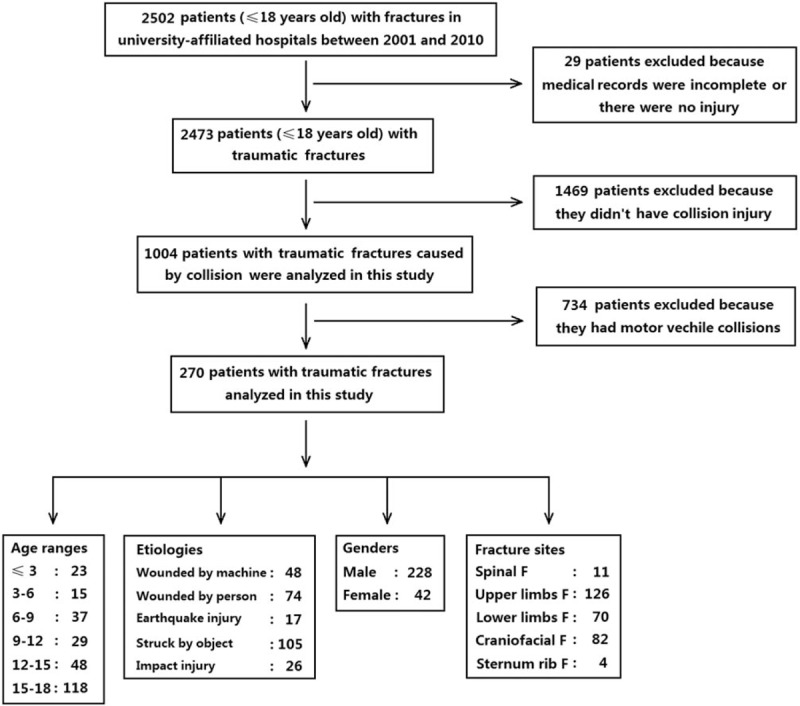
Patient flow diagram.
2.2. Statistical analysis
We performed all statistical analyses using SPSS 22.0 (SPSS Inc, Chicago, IL). The Pearson chi-square test was conducted for assessing differences in age, sex distribution, and clinical characteristics between 2 groups. The continuous variables such as current age were tested for the normal distribution by the 1-sample Kolmogorov-Smirnov test and were expressed as mean ± standard deviation.
3. Results
3.1. Demographic features and general characteristics
The study included 228 males and 42 female patients with a mean age of 12.8 ± 5.1 years old, and a sex ratio of 5.4 (m:f). The most common etiologies were struck by object (105, 38.9%) followed by wounded by person (74, 27.4%). The overall annual incidence of TFs caused by collision in children and adolescents was (25.4 ± 18.9) patients per 100,000 HAs per year. The most common fracture sites were upper limb (126, 46.7%) and craniofacial (82, 30.4%), followed by lower limb (70, 25.9%). The most common distributions of areas where children's fractures occurred were schools and public premises (157, 58.1%), residential areas (47, 17.4%), working areas (46, 17.0%), and sports areas (20, 7.4%). The incidences had a little seasonal variation and a substantial time variation, with peaks in summer (30.0%) and 12:00 to 16:00 (31.5%) (Fig. 2).
Figure 2.
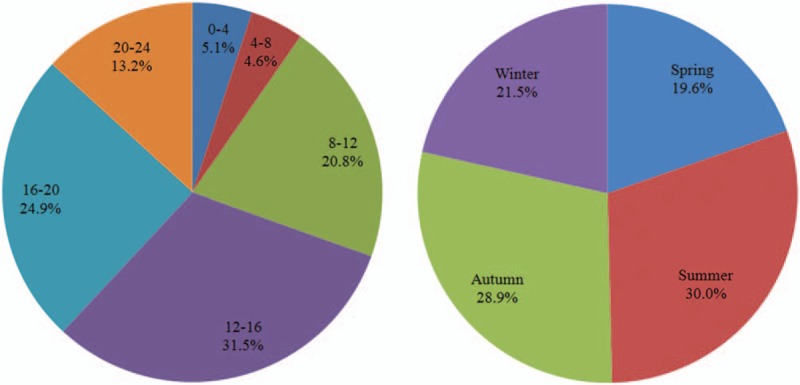
Time and season distribution of all 270 patients.
Among the 126 patients presenting with upper limb fractures, there were humerus fractures in 25 patients (19.8%), radial fractures in 18 patients (14.3%), ulna fractures in 22 patients (17.5%), fractures of the clavicle in 12 patients (9.5%), metacarpal fractures in 19 patients (15.1%), and phalangeal fracture in 41 patients (32.5%). Among the 82 patients presenting with craniofacial fractures, there were parietal fractures in 24 patients (29.3%), frontal fractures in 16 patients (19.5%), temporal fractures in 12 patients (14.6%), occipital fractures in 9 patients (11.0%), and skull base fractures in 7 patients (8.5%). There were mandible fractures in 10 patients (12.2%), nasal fractures in 10 patients (12.2%), orbital fractures in 4 patients (4.9%), maxillary fracture in 1 patient (1.2%), and zygomatic fracture in 1 patient (1.2%). Among the 70 patients presenting with lower limb fractures, there were femoral fracture in 26 patients (37.1%), tibia fractures in 21 patients (30.0%), fibula fractures in 14 patients (20.0%), calcaneal fractures in 3 patients (4.3%), pelvic fracture in 5 patients (7.1%), patellar fracture in 1 patient (1.4%), and talus fractures in 4 patients (5.7%).
A total of 65 (24.1%) patients suffered a nerve injury. Among the patients presenting with nerve injury, there was brain injury in 37 patients (56.9%), spinal cord injury in 2 patients (3.1%), cranial nerve injury in 2 patients (3.1%), and spinal nerve injury in 25 patients (38.5%). A total of 96 (35.6%) patients presented with associated injuries (ASOIs), and 23 patients (8.5%) presented with complications.
3.2. Characteristics in respect to different age groups
The most common age group was 15 to 18 years (n = 118, 43.7% of all patients) and the patients in this age group had the largest sex ratio (9.7). The patients in the age group of 3 to 6 years had the lowest sex ratio (1.1). The emergency admission rate was highest in the age group of 15 to 18 years (54.2%) and lowest in age group of ≤3 years (39.1%).
The most common aetiologies were struck by object (47.8%) and wounded by machine (39.1%) in the age group of ≤3 years, struck by object (66.7%) and impact injury (13.3%) in the age group of 3 to 6 years, struck by object (62.2%) and wounded by person (21.6%) in the age group of 6 to 9 years, struck by object (62.1%) in the age group of 9 to 12 years, wounded by person (52.1%) and struck by object (25.0%) in the age group of 12 to 15 years, wounded by person (31.4%) and wounded by machine (28.0%) in the age group of 15 to 18 years. The frequency of wounded by machine was significantly higher in the ≤3 year group (39.1%) than in the other groups, except for the age group of 15 to 18 years (all P < .05). The frequency of wounded by person was significantly higher in the age group of 12 to 15 years (52.1%) than in the other groups (all P < .05).
The most common fracture sites were upper limb (60.9%) and craniofacial (26.1%) in the age group of ≤3 years, lower limb (53.3%) and upper limb (33.3%) in the age group of 3 to 6 years, craniofacial (40.5%) and upper limb (35.1%) in the age group of 6 to 9 years, craniofacial (37.9%) and lower limb (34.5%) in the age group of 9 to 12 years, upper limb (39.6%) and craniofacial (35.4%) in the age group of 12 to 15, and 15 to 18 years. The frequency of upper limb fracture was higher in the age group of ≤3 years (60.9%) and 15 to 18 years (56.8%) than in the other groups. The frequency of lower limb fractures was higher in the age group of 3 to 6 years (53.3%) than in the other groups. The frequency of craniofacial fracture was higher in the age group of 6 to 9 years (40.5%) than in the other groups (Table 1).
Table 1.
Characteristics of 270 traumatic fractures resulting from collisions according to different age range groups.
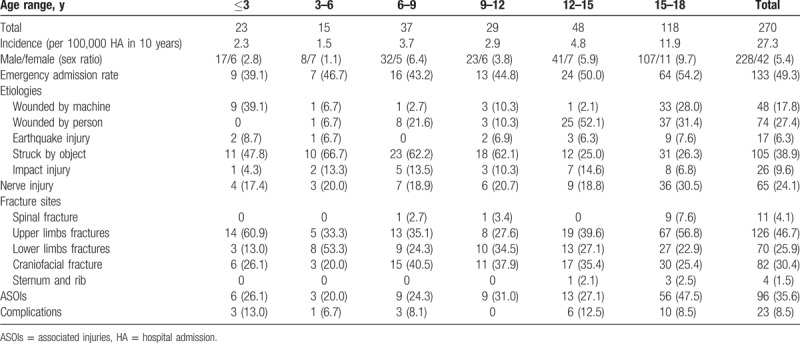
3.3. Characteristics in respect to different sexes
The emergency admission rate was 50.0% in the male patients and 45.2% in the female patients. The frequency of nerve injury, ASOIs, and complications was 25.0%, 35.5%, and 7.9% in the male patients, respectively, and 19.0%, 35.7%, and 11.9% in the female patients, respectively. The most common etiologies were struck by object, wounded by person, and wounded by machine in the male patients, and struck by object, earthquake injury, and wounded by machine in the female patients.
The mean age (P = .001, t = 3.209) and frequency of wounded by person (P = .038, t = 4.304) was significantly higher in male than in female patients. The frequency of earthquake injury (P < .001, t = 29.491) and lower limb fractures (P = .002, t = 9.659) was significantly higher in female than in male patients (Table 2).
Table 2.
Characteristics of 270 traumatic fractures resulting from collisions according to different sexes.
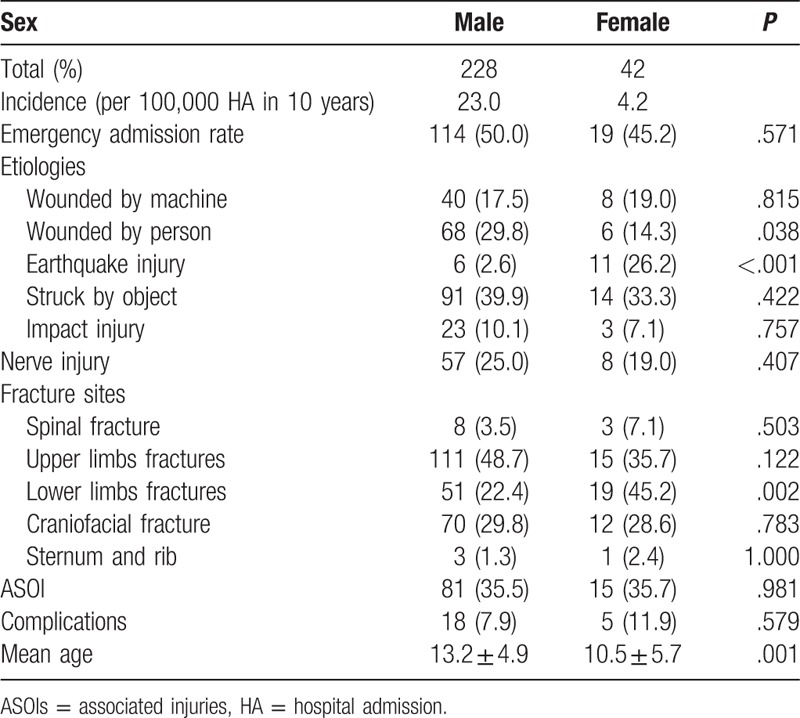
3.4. Characteristics in respect to different etiologies
The patients in the wounded by person group had the highest sex ratio (11.3), and patients in the earthquake injury group had the lowest sex ratio (0.5). The emergency admission rate was highest in the wounded by machine group (56.3%) and the wounded by person group (59.5%). The frequency of nerve injury and ASOIs was highest in the wounded by person group (39.2%, 51.4%, respectively) and lowest in the impact injury group (3.8%, 7.7%, respectively). The frequency of complications was highest in the earthquake injury group (35.3%) and lowest in the impact injury group (0). The most common fracture sites were upper limb (83.3%) in the wounded by machine group, craniofacial (54.1%) and upper limb (41.9%) in the wounded by person group, lower limb (64.7%) and upper limb (29.4%) in the earthquake injury group, lower limb (39.0%) and upper limb (34.3%) in the struck by object group, and upper limb (53.8%) in the impact injury group. The frequency of upper limb fracture was significantly higher in the wounded by machine group (83.3%) than in the other groups (all P < .05). The frequency of lower limb fractures was significantly higher in the earthquake injury group (64.7%) than in the other groups (all P < .05). The frequency of craniofacial fracture was significantly higher in the wounded by person group (54.1%) than in the other groups (all P < .05) (Table 3). The emergency admission rate (P = .047), frequency of wounded by person (P < .001), craniofacial fracture (P < .001), and ASOIs (P < .001) were significantly higher in patients with nerve injury than in the other patients (Table 4).
Table 3.
Characteristics of 270 traumatic fractures resulting from collisions according to different etiologies.
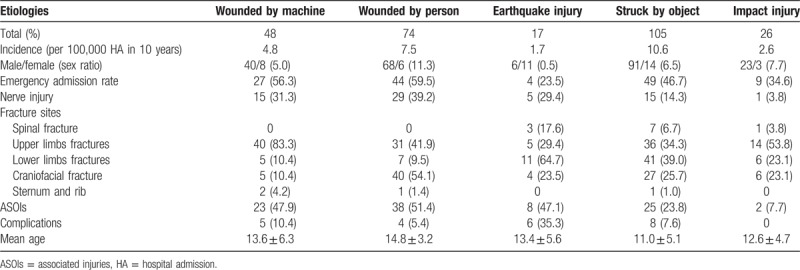
Table 4.
Characteristics of 270 traumatic fractures resulting from collisions according to nerve injury.
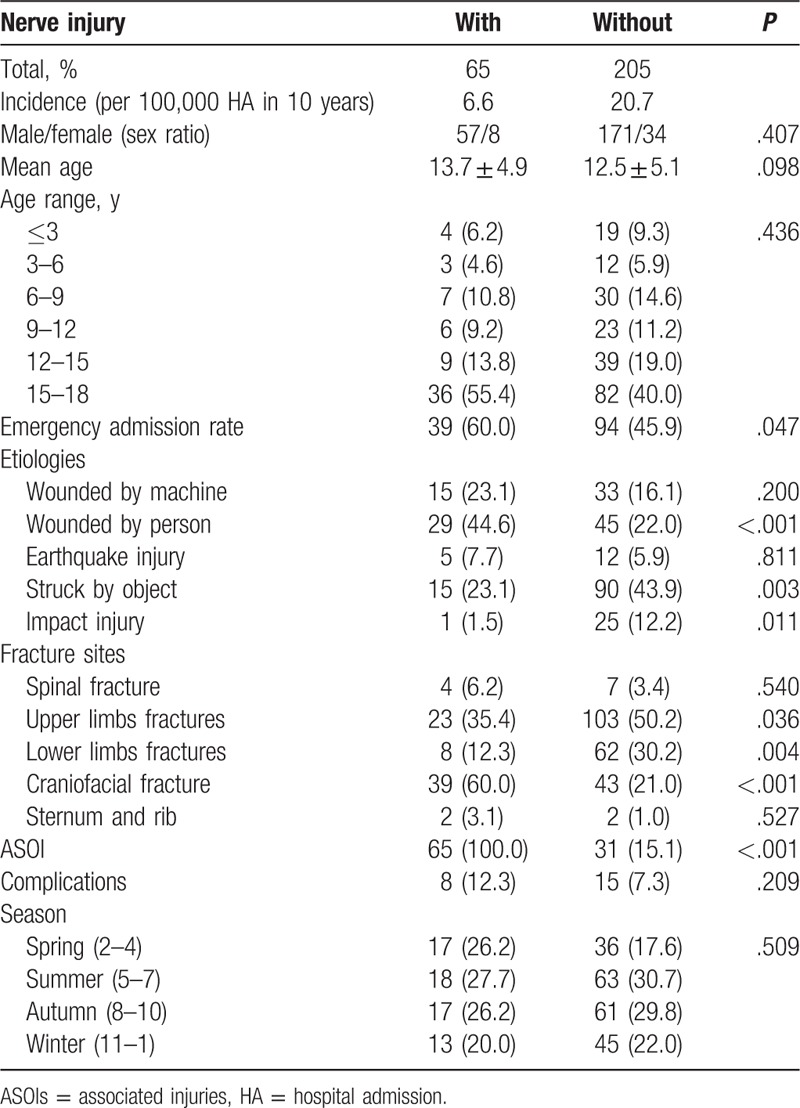
4. Discussion
This study was a retrospective cross-sectional study using data from the Military Hospital Information Registry Database gathered from January 2001 to December 2010. Data were collected from the 2 biggest hospitals affiliated with the Third Military Medical University in Chongqing, China. The tertiary hospitals are located in the Shapingba district, which is a core district located in the northwest of Chongqing city. In the current study, rates of fracture were higher among boys than among girls, with a sex ratio of 5.4, which accord with previously published data.[15] Male incidence rates peak later than those of females; these results were consistent with a previous study.[16] The mean age and frequency of wounded by person was significantly higher in males than in female patients, so we should pay much more attention to the male adolescent patients, who are more likely to fight than female patients. The frequencies of earthquake injury and lower limb fractures were significantly higher in female than in male patients. This phenomenon could be explained by the fact that female children have poorer athletic ability than male children. The incidences had a little seasonal variation and a substantial time variation, with peaks in summer (30.0%) and 12:00 to 16:00 (31.5%). The most common distributions of areas where fractures occurred were schools and public premises (157, 58.1%), residential areas (47, 17.4%), working areas (46, 17.0%), and sports areas (20, 7.4%). We believe the pattern of TFs among children and adolescents caused by collisions is partly explained by changes in children's activity patterns and states of mind over time. In addition, the number of patients treated for collision-related fractures increased with age. Pediatric collisions are preventable injuries which may result in serious injury, such as nerve injury (24.1%), ASOIs (35.6%), and complications (8.5%). Preventive measures should be considered, including increasing public awareness and caregiver education, especially in schools and public premises, residential areas, and working areas.
The most common fracture regions were upper limb fractures (46.7%) and craniofacial fracture (30.4%), followed by lower limb fractures (25.9%). The most common fracture sites were the phalanx (n = 41, 15.2%), femur (n = 26, 9.6%), humerus (n = 25, 9.3%), and parietal bone (n = 24, 8.9%). A previous study showed that most fractures (73%) involved upper lower extremities (22%).[3] Most studies showed that forearm fracture was the most common diagnosis,[17] but the fractures in the studies were caused by all etiologies, not only fractures caused by collision. The frequency of upper limb fracture was significantly higher in the wounded by machine group than in the other groups. This phenomenon could be explained by the fact that manual workers were found to be more likely than other patients to be injured by machine. The frequency of lower limb fractures was significantly higher in the earthquake injury group than in the other groups. This phenomenon could be explained by the fact that earthquake injuries are complex and involve severe damage. Most of them are crush injuries, and lower limbs are more likely to fracture. The frequency of craniofacial fracture was significantly higher in the wounded by person group than in the other groups. This phenomenon could be explained by the fact that people often hit each other's faces and heads when they are fighting. Therefore, we can see that the pattern of fractures among the patients caused by collisions has its own characteristics; targeted intervention methods should be taken to decrease the incidence and burden of collisions.
In our study population, the frequency of nerve injury was 24.1%. The patients in the age group of 15 to 18 years had the highest frequency of nerve injury (30.5%). The emergency admission rate, frequency of wounded by person, craniofacial fracture, and ASOIs were significantly higher in patients with nerve injury than in the other patient groups. Wounded by person and craniofacial fracture were risk factors for nerve injury. Therefore, we should pay more attention to patients wounded by person and presenting with craniofacial fracture to find whether there is nerve injury. In the current study, a total of 96 (35.6%) patients sustained ASOIs, and 23 (8.5%) patients sustained complications. The early detection and treatment of nerve injury, timely discover and treatment of ASOIs in TFs among children and adolescent patients is very important.
This study has several limitations. First, it was limited by the retrospective study design, the small sample size, and selection bias, because this study included patients who were referred to our teaching hospitals. Second, patients followed up as outpatients in the clinics department were not included because electronic medical records regarding outpatients were not available. Nevertheless, our study was the most current study to show the incidence and pattern of TFs as a result of collisions in children and adolescents of China. Developing countries such as China with rapid development may benefit from the epidemiology study and researchers can prevent or reduce the happening of TFs resulting from collisions through simple environmental modifications and education. We propose to undertake multicenter and large-scale collaborative studies to produce more comprehensive information regarding the incidence and pattern of fractures involving collisions among the children and adolescents.
5. Conclusions
Struck by object and upper limb fractures were the most common etiology and sites, respectively. Wounded by person and craniofacial fracture were risk factors for nerve injury. Therefore, we should pay more attention to patients wounded by persons and presenting with craniofacial fracture to determine whether there is nerve injury. Then, we may achieve early detection and treatment of nerve injury in TFs among children and adolescent patients.
Author contributions
Conceptualization: Hongwei Wang, Huan Liu, Changqing Li.
Data curation: Hongwei Wang, Huan Liu, Song Zhang, Changqing Li, Yue Zhou, Jun Liu, Lan Ou, Liangbi Xiang.
Formal analysis: Hongwei Wang, Song Zhang, Changqing Li, Yue Zhou, Lan Ou, Liangbi Xiang.
Funding acquisition: Hongwei Wang.
Investigation: Hongwei Wang, Yue Zhou, Jun Liu, Lan Ou, Liangbi Xiang.
Methodology: Hongwei Wang, Jun Liu, Lan Ou.
Project administration: Hongwei Wang, Jun Liu, Lan Ou.
Resources: Hongwei Wang, Jun Liu.
Software: Song Zhang, Jun Liu, Lan Ou.
Supervision: Hongwei Wang, Huan Liu, Yue Zhou, Jun Liu, Liangbi Xiang.
Validation: Hongwei Wang, Song Zhang, Lan Ou, Liangbi Xiang.
Visualization: Lan Ou, Liangbi Xiang.
Writing – original draft: Hongwei Wang, Huan Liu, Song Zhang, Changqing Li, Yue Zhou, Jun Liu, Lan Ou.
Writing – review and editing: Changqing Li, Liangbi Xiang.
Footnotes
Abbreviations: ASOIs = associated injuries, HA = hospital admission, TF = traumatic fracture.
HW and HL contributed equally to this work.
This work was supported by the Foundation of the Liaoning Province Doctor Startup Fund (201601389), the State Key Laboratory of Robotics (2017-001), the Open Project Program of the State Key Lab of CAD&CG (A1718), the Open Project Program of the State Key Laboratory of Trauma, Burn and Combined Injury (SKLKF201705), and the State Key Laboratory of Materials Processing and Die and Mould Technology (P2018-011).
The authors report no conflicts of interest.
References
- [1].Kopjar B, Wickizer TM. Fractures among children: incidence and impact on daily activities. Inj Prev 1998;4:194–7. [DOI] [PMC free article] [PubMed] [Google Scholar]
- [2].Lyons RA, Delahunty AM, Kraus D, et al. Children's fractures: a population based study. Inj Prev 1999;5:129–32. [DOI] [PMC free article] [PubMed] [Google Scholar]
- [3].Mäyränpää MK, Mäkitie O, Kallio PE. Decreasing incidence and changing pattern of childhood fractures: a population-based study. J Bone Miner Res 2010;25:2752–9. [DOI] [PubMed] [Google Scholar]
- [4].Hedström EM, Svensson O, Bergström U, et al. Epidemiology of fractures in children and adolescents. Acta Orthop 2010;81:148–53. [DOI] [PMC free article] [PubMed] [Google Scholar]
- [5].Benoit R, Watts DD, Dwyer K, et al. Windows 99: a source of suburban pediatric trauma. J Trauma 2000;49:477–81. [DOI] [PubMed] [Google Scholar]
- [6].Mirdad T. Fractures of the neck of femur in children: an experience at the Aseer Central Hospital, Abha, Saudi Arabia. Injury 2002;33:823–7. [DOI] [PubMed] [Google Scholar]
- [7].Krug EG, Sharma GK, Lozano R. The global burden of injuries. Am J Public Health 2000;90:523–6. [DOI] [PMC free article] [PubMed] [Google Scholar]
- [8].Bartlett SN. The problem of children's injuries in low-income countries: a review. Health Policy Plan 2002;17:1–3. [DOI] [PubMed] [Google Scholar]
- [9].Mattila V, Parkkari J, Kannus P, et al. Occurrence and risk factors of unintentional injuries among 12- to 18-year-old Finnsa survey of 8219 adolescents. Eur J Epidemiol 2004;19:437–44. [DOI] [PubMed] [Google Scholar]
- [10].Jerrhag D, Englund M, Petersson I, et al. Increasing wrist fracture rates in children may have major implications for future adult fracture burden. Acta Orthop 2016;87:296–300. [DOI] [PMC free article] [PubMed] [Google Scholar]
- [11].Cooper C, Dennison EM, Leufkens HG, et al. Epidemiology of childhood fractures in Britain: a study using the general practice research database. J Bone Miner Res 2004;19:1976–81. [DOI] [PubMed] [Google Scholar]
- [12].Wang H, Yu H, Zhou Y, et al. Traumatic fractures as a result of falls in children and adolescents: a retrospective observational study. Medicine (Baltimore) 2017;96:e7879. [DOI] [PMC free article] [PubMed] [Google Scholar]
- [13].Wang H, Zhou Y, Liu J, et al. Traumatic fractures as a result of motor vehicle collisions in children and adolescents. Int Orthop 2018;42:625–30. [DOI] [PubMed] [Google Scholar]
- [14].Wang H, Zhou Y, Liu J, et al. Traumatic skull fractures in children and adolescents: a retrospective observational study. Injury 2018;49:219–25. [DOI] [PubMed] [Google Scholar]
- [15].Pickett W, Streight S, Simpson K, et al. Injuries experienced by infant children: a population-based epidemiological analysis. Pediatrics 2003;111:e365–70. [DOI] [PubMed] [Google Scholar]
- [16].Macgregor DM. Accident and emergency attendances by children under the age of 1 year as a result of injury. Emerg Med J 2003;20:21–4. [DOI] [PMC free article] [PubMed] [Google Scholar]
- [17].Howard A, Rothman L, McKeag AM, et al. Children in side-impact motor vehicle crashes: seating positions and injury mechanisms. J Trauma 2004;56:1276–85. [DOI] [PubMed] [Google Scholar]


